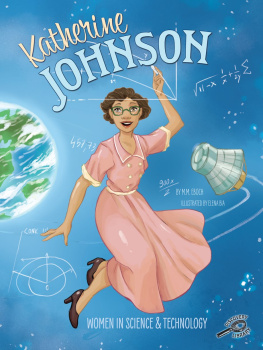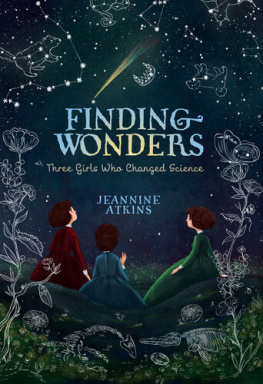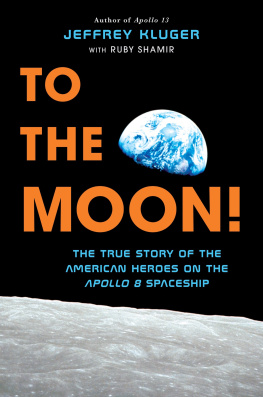Id like to dedicate this book to the memory of my father, Joshua Coleman, and my mother, Joylette Lowe Coleman, as well as to the children whom my story will inspire to reach for the moon in their own lives.
I ts not every day you wake up with a mission on your mind, but I had a mission and I was determined to accomplish it. Except for the sound of Mama humming and the clinking of dishes as she washed them in the sink, the house was quiet. Moments earlier Daddy had left for work and my brothers and sister had set off to school. As I sat at the kitchen table still fiddling with my oatmeal, I couldnt get my brother Charlie out of my mind. I kept revisiting the scene at the kitchen table the night before, when hed struggled with his math homework.
First Mama had tried to assist him with it. Back before shed had Horace, Margaret, Charlie, and me, she had been a teacher. She should have been able to help him figure out his schoolwork.
But the way he had slumped over onto one elbow had signaled that he was feeling frustrated.
Sit up straight, Mama had told him, and he did.
Horace and Margaret were steadily scribbling away at their assignments, apparently unbothered by Charlies challenges.
Maybe you can explain it better than I can, Josh, Mama said to Daddy, who was sitting in the front room reading the White Sulphur Sentinel , our towns newspaper. Daddy loved to read the paper. He also read the almanac. Mama adored us, but she was very orderly and from time to time she could be a bit strict. Our father was a little more relaxed.

My parents, Joshua and Joylette Coleman.
Daddy set the paper down and slowly unfurled himself from his favorite chair. More than six feet tall, he towered above most everyone.
Lets see what we can do here, Son, he said, sitting down and scooting closer to his youngest son, the chair scraping loudly across the oak floor.
Daddy put his left arm around Charlie, who leaned into him.
I cant figure it out, Charlie said, his lack of confidence evident in his voice.
Yes, you can, Daddy told him. We just have to explain it so that you get it. Once you understand the background of any idea, you can figure any problem out for yourself.
Daddys personality could be more comforting than Mamas. Numbers were also Daddys strength. He may have had only a sixth-grade education, but he was really good with figures. Envisioning things was one of his strong points. He was so good that he could look at an entire oak, pine, or even a chestnut tree, and tell you how many logs it would yield once it had been cut down. We even lived in a home he had built for us.
Charlie was two years older than me, but for some reason he seemed to be a little slow. At least, thats what I thought back then. I would be well into adulthood before I discovered that the issue wasnt that he was slow. The truth of the matter was that I was fast. It turned out that I was very gifted in math.
Math had always come easily to me. I loved numbers and numbers loved me. They followed me everywhere. No matter what I did, I was always finding something to count: the floorboards, the cracks in the sidewalk, the trees as I walked by, the train cars stacked with timber and those piled with coal that lumbered along the edge of our town each day. The number of times the train engineers blew the whistle as they traveled through the trees, echoing off the granite bedrock that rose above us and formed the valley within which our town, White Sulphur Springs, West Virginia, was nestled.

Me at age two with my brothers and sister.
That was just the way that my mind worked. One, two, three, four, five, six, seven, eight forks. One, two, three, four, five, six, seven, eight plates. One, two, three serving spoons. Mama was very well organized, but my mind took her sense of order one step further. I always knew how many of everything there were. Things were there and could be counted and accounted for, so thats what I did.
So when Charlie found it hard to understand numbers, it really bothered me. And it disturbed me even more when he didnt understand even after both Mama and Daddy had tried to teach them to him.
At that point I decided to take things into my own hands. And that was why, even though I was only four years old, I told my plan to Mama, then walked out the front door, then four steps across the porch, eight steps down the front stairs, and five steps down the front walk, and set off toward the school.
As I marched out of our front yard and turned onto the sidewalk, I waved at Mrs. Hopkins, who was sweeping the front porch of her familys two-story house across our street. Church Street was the center of Colored life in White Sulphur Springs. Back then the same people we now call African American or Black were called Colored or Negro. (Its important not to use those words to describe people today or you will certainly offend them.)
I strode slightly uphill past five houses and St. James United Methodist Church, where we worshipped, to the corner of Barton Road. Thats where Church Street ended, as what had been a slight rise suddenly became very steeptoo steep to sled after the snow fell. It was covered with maple, sycamore, and pine trees, and during the spring and summer months, grass.
About one hundred yards up that hill ran the Chesapeake and Ohio Railway tracks, where black and navy-blue trains with a yellow Cheshire cat painted on them rumbled through town twice daily, morning and evening. The C&O trains carried coal, lumber, and supplies as well as people from the Virginia coast (which was about six hours southeast) northwestward through the Allegheny Mountains, part of the Appalachian mountain range of West Virginia and southern Ohio. The C&O then carried its load over the Ohio River, across that state on into Detroit and other parts of Michigan. Some trains traveled even farther westward into Indiana and on to the growing industrial cities of Gary, Indiana, and Chicago, Illinois.
A passenger train also rolled through town, carrying not only travelers of modest means but also the well-appointed private coaches that the wealthy magnates of that era owned and used to travel around the country.
I turned left onto Barton and followed it one block until I came to a dirt path on my right. About one hundred feet up that path sat the Mary McLeod Bethune Grade School, the white wooden two-room schoolhouse where our towns Colored children were educated. The White children who lived in White Sulphur, as we affectionately called our town, went to the all-White school across town that the Colored students werent allowed to attend.
The reason that Colored children and White children went to separate schools dated way back to slavery. Many White people convinced themselves that Colored people were an inferior race and so justified using guns, whippings, beatings, rape, and other violence to enslave Colored people and force them to work for Whites. These attitudes and behaviors were prevalent for many decades after slavery ended, including in education.
In its 1857 Dred Scott decision, our nations highest court, the Supreme Court, ruled that Colored people were an inferior and subordinate class of beings as compared to Whites. Many White people then used the ruling to justify ongoing efforts to degrade and exploit Colored people. Then, in its 1896 Plessy v. Ferguson decision, the Supreme Court legalized separate but equal facilities that were segregated by race. But everyone knew that separate also meant unequal. And that is why Mary McLeod Bethune was a two-room school located on a dirt road rather than a paved one like the all-White schools.












